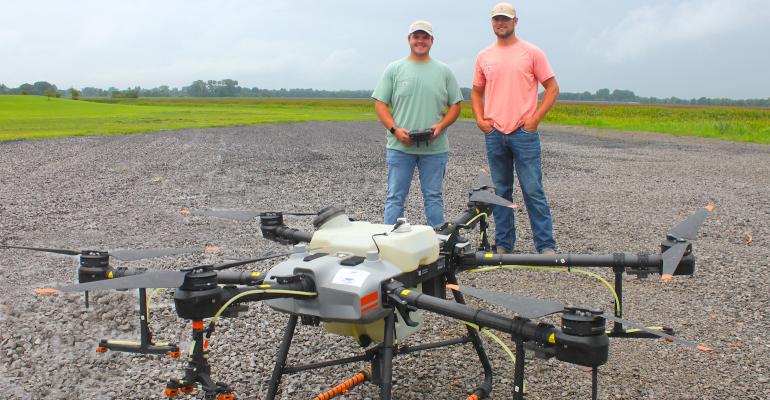It's hard to believe that we are days away from the end of 2021. Before you know it, we will be...
Agricultural Drone Spraying Taking Off

Agricultural drone spraying is no passing fad — at least according to KD Bohon. Bohon is the Business Development Manager at Agri Spray Drones, so, of course that’s what you would expect him to say. But a captivated audience at a recent spray demo in Jackson, Tennessee, tells its own story, as do the numbers of spray drones heading to farms.
“We’ve sold around 350 units just this summer,” said Bohon, “which is a huge jump over the previous year. This technology is really gaining momentum.” He demoed the Agras T-30, an 8-gallon spray drone that can cover 30 acres per hour on average, according to the company. After importing a field boundary and parameters, the drone flies autonomously, returning to the loading site when the tank is empty and batteries need charging.
“Typically, people who see the drone in action are very impressed,” Bohon said. “We still get some skeptics who say, ‘If I can’t get 600 acres a day, I don’t want it.’ But many of our users have found that in certain circumstances the drone is better than planes or choppers because the timing is optimal.” One such user is Hunter Burks, a farmer in western Tennessee who purchased two drones from Agri Spray after seeing a spray demo in a fellow farmer’s field. “I think it’s really going to be something,” Burks said. “How many times when we need to be spraying is it either too muddy to get in the field, or we can’t get a plane scheduled? Wait long enough and that adds up to yield loss. I see a lot of opportunity with drones.”
Hunter Burks and Jacob Tribble have teamed up to test drone spraying on the Burks’ family farm this season. From the results they’ve seen, they plan to launch a commercial application business in 2023.
“Many people want to see these demonstrations because it’s cool, but then they see that drone spraying is also effective, and they’re interested in trying it on their own farms. We see a lot of potential uses — spraying fungicide and insecticide in crops, applying foliar feed in hay fields, and you could do some spot spreading of fertilizer. I plan to plant some food plots with it this fall,” Burks said.
As interest in drone spraying increases and farmers begin to experiment with this new venture, it’s clear there are advantages to the technology — timely applications on hard-to-reach fields, flexibility in usage, as well as opportunities for new business ventures in rural areas. But there are factors that call for serious consideration, as well. What are the requirements of drone pilots? Is it more cost effective to buy your own drone or contract with custom applicators? Do you have the time and labor resources needed to spray efficiently with a drone? And, most importantly, does it work?
Costs and learning curve
If drones are a solution to timely applications of pesticides, the next question may be should I buy my own drone or contract with a commercial applicator? Most commercial drone applicators are currently charging $11-14 per acre — rates that are competitive with traditional aerial applications.
To operate your own drone may only cost $1 per acre, but there is the upfront investment of the drone itself, a trailer to haul it, generators to charge batteries, water tank, mixing tank, insurance and license fees.
Burks cautions that learning to operate a spray drone is a timely endeavor. “When it comes to operating your own drone, time may be the biggest barrier to entry for some farmers.”

Before flying, even on your own farm, operators need a drone pilot’s license, an aerial applicator’s license, a state pesticide applicator’s license, an FAA physical, and certificates of exemption to fly a drone over 55 lbs. If you plan to fly at night that’s another certification, as is flying a swarm of drones.
“It can feel overwhelming when you look at all the studying and preparation that is needed to be able to fly a drone,” Tribble said. “You’ll need to devote several weeks to studying for the drone pilot’s license. There is a lot of preparation involved in collecting documentation and working with different agencies.”
Many drone companies will provide a service that helps operators navigate regulations as well as insurance needs. Burks and Tribble used this service, and said it was a valuable investment. Still, the process took more than six months to complete.
Learning to fly the drone may take longer than expected, even for those who have previous drone training. Both Burks and Tribble had experience operating small drones but admitted there was a learning curve with flying the larger spray drone.
“You go from flying a 1-pound drone to a 160-pound drone fully loaded and it is much harder to stop,” said Tribble. “That was an adjustment that required some extra training on our part.”
“Flying the drone is harder than they make it sound,” said Burks. “When the drone senses obstacles, like trees or a center pivot, you have to manually adjust. You can’t just set back and let it fly itself.”
Operating a spray drone is a two-person job. Tribble flies the drone as Burks serves as visual line of sight observer. When the drone tank is empty, one will refill while the other changes and charges batteries.
As Burks and Tribble have experimented with the technology, they are confident drone sprayers have a place in agriculture.
Another benefit — neighbors never hear the drone. “I think some people are still skeptical, but as more research comes out, I think they’ll come around,” Tribble added. “Drone spraying is going to take off.”
Editor’s Take:
Farmers and ranchers are typically intrigued by new technology. They also love to experiment with it to determine for themselves just how it could help improve their operation. This article points to a new form of fertilizer and crop protection application that seems to hold promise, especially after a crop is in a more mature phase of development or in a difficult area to reach by another method. We can also count on land-grant universities to engage in research which should help prove or disprove such technology use on the farm.
As a CAD dealer, you have not only the technology from your OEM(s), but the technology within AgPack. AgPack is an economic advantage to both you and farmers/ranchers in your area, and the offerings are full of the latest technologies from manufacturers who are leaders in their respective industries. If you want to learn more about these companies and what they really offer, go to the Certified Ag Dealer website or call one of our knowledgeable CAD Dealer Service Advisors today!







